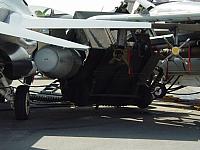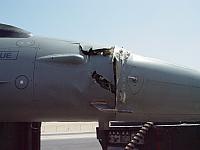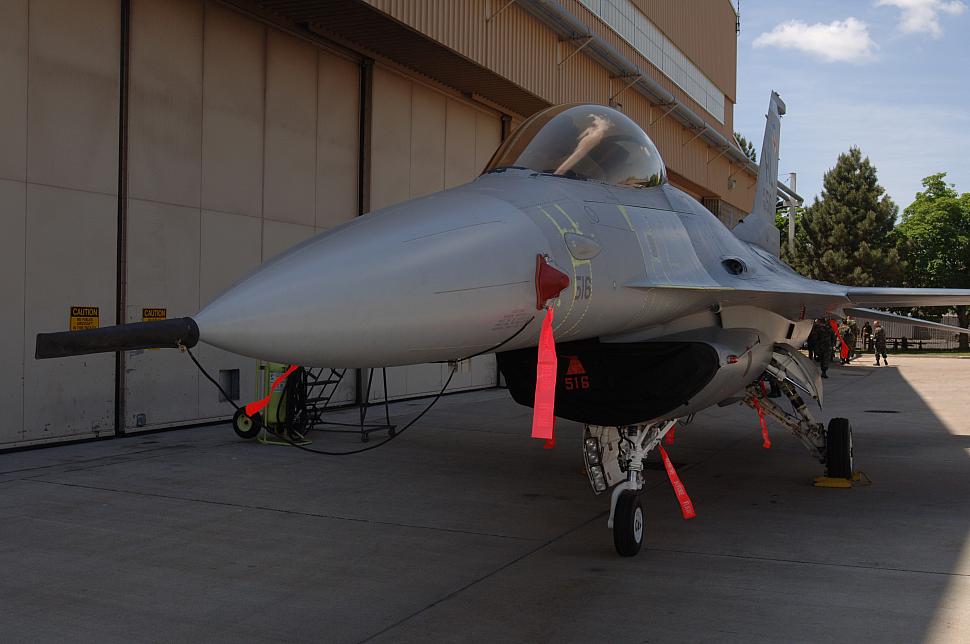Fighter Jet News
F-16 Fighting Falcon News
F-16 repaired, ready to fly
May 10, 2007 (by
Hilltop Times) -
After investing two years of maintenance work and $1.1 million to repair a crash-damaged F-16, maintainers from the 649 CLSS returned the aircraft to its owner, the 388th Fighter Wing, during a ceremony at Hill AFB on Monday.
The returned aircraft (#88-0516) is one of two F-16s belonging to the 388 FW's 421st Fighter Squadron that were damaged during a 2003 deployment. After losing hydraulic pressure and control, the first aircraft impacted a parked aircraft on the tarmac of an air base in southwest Asia.
"At $30 million a copy per F-16, this has been an exceptional return on investment for the Air Force," said Lt. Col. Dan Sny, commander of the 309th Maintenance Wing's 649 CLSS. "It's a great investment on an aircraft that would otherwise be retired."
Brig. Gen. Art Cameron, 309th Maintenance Wing commander, and Col. Robert Beletic, 388 FW commander, marked the aircraft's return with a formal signing-over ceremony.
"The 309 MXW is all about increasing combat capability," said General Cameron. "What we're doing here today is helping increase the lethality of the 388 FW by giving them back iron."
"The 388 FW's mission to train, deploy, and execute for the nation could not happen without the work of its Air Force Material Command counterparts at Hill AFB," said Colonel Beletic. "This single F-16 will provide an average 18.4 sorties each month, from now until the 421 FS deploys, in essential training for our pilots and maintainers."
The return of the damaged jet will greatly benefit the 421 FS. While many of its aircraft are currently undergoing depot upgrades, aircraft availability rates in the squadron are low.
The return of this aircraft and, eventually, the second aircraft will increase the fleet by eight percent, according to Lt. Col. Geoffrey Bacon, 388th Aircraft Maintenance Squadron commander. "Availability of more aircraft helps to ensure both the active duty personnel from the 388 FW and the integrated Reserve personnel from the 419 FW are able to fly and train to the needs of the mission," he said.
In 2003, the 649 CLSS was tasked by the Safety Investigation Board to evaluate both damaged aircraft for repair. The squadron deployed a 10-member team to disassemble and ship both aircraft to Hill AFB for repair in their maintenance facility.
"Ironically, we had to go all the way to the desert to pick up two planes that belong to a wing stationed here," Colonel Sny said. "The phase one evaluation of the damage was done about four years ago, but we didn't bring the aircraft into maintenance until about two years ago because of other workloads. Our hangar only has room for four F-16s at one time."
The F-16 System Program Office at Wright Patterson Air Force Base, Ohio, reviewed the 649 CLSS maintenance plan and provided guidance to ensure the repairs will keep the aircraft flying. During maintenance work on the parked aircraft, the 649 CLSS replaced more than 50 structural components from the left side of the cockpit, including two that were locally manufactured because they weren't available through normal supply channels.
Over the past two years, the 649 CLSS Crash Damage Repair program has returned seven F-16s, which would otherwise have been retired, back to warfighters across the Air Force. In addition to CDR, the 649 CLSS deploys 60 Depot Field Teams annually to perform heavy depot maintenance that is beyond the capabilities of the field-level maintenance organizations.
"A lot of our work is at remote locations," Colonel Sny said. "It can be in Iraq or a Guard unit in Des Moines, Iowa, and anything in between to include foreign military sales. We do work in Egypt, Taiwan, Bahrain -- we service the entire F-16 fleet worldwide, regardless of which air force it belongs to."
The second aircraft is scheduled for completion in August.
"At $30 million a copy per F-16, this has been an exceptional return on investment for the Air Force," said Lt. Col. Dan Sny, commander of the 309th Maintenance Wing's 649 CLSS. "It's a great investment on an aircraft that would otherwise be retired."
Brig. Gen. Art Cameron, 309th Maintenance Wing commander, and Col. Robert Beletic, 388 FW commander, marked the aircraft's return with a formal signing-over ceremony.
"The 309 MXW is all about increasing combat capability," said General Cameron. "What we're doing here today is helping increase the lethality of the 388 FW by giving them back iron."
"The 388 FW's mission to train, deploy, and execute for the nation could not happen without the work of its Air Force Material Command counterparts at Hill AFB," said Colonel Beletic. "This single F-16 will provide an average 18.4 sorties each month, from now until the 421 FS deploys, in essential training for our pilots and maintainers."
The return of the damaged jet will greatly benefit the 421 FS. While many of its aircraft are currently undergoing depot upgrades, aircraft availability rates in the squadron are low.
The return of this aircraft and, eventually, the second aircraft will increase the fleet by eight percent, according to Lt. Col. Geoffrey Bacon, 388th Aircraft Maintenance Squadron commander. "Availability of more aircraft helps to ensure both the active duty personnel from the 388 FW and the integrated Reserve personnel from the 419 FW are able to fly and train to the needs of the mission," he said.
In 2003, the 649 CLSS was tasked by the Safety Investigation Board to evaluate both damaged aircraft for repair. The squadron deployed a 10-member team to disassemble and ship both aircraft to Hill AFB for repair in their maintenance facility.
"Ironically, we had to go all the way to the desert to pick up two planes that belong to a wing stationed here," Colonel Sny said. "The phase one evaluation of the damage was done about four years ago, but we didn't bring the aircraft into maintenance until about two years ago because of other workloads. Our hangar only has room for four F-16s at one time."
The F-16 System Program Office at Wright Patterson Air Force Base, Ohio, reviewed the 649 CLSS maintenance plan and provided guidance to ensure the repairs will keep the aircraft flying. During maintenance work on the parked aircraft, the 649 CLSS replaced more than 50 structural components from the left side of the cockpit, including two that were locally manufactured because they weren't available through normal supply channels.
Over the past two years, the 649 CLSS Crash Damage Repair program has returned seven F-16s, which would otherwise have been retired, back to warfighters across the Air Force. In addition to CDR, the 649 CLSS deploys 60 Depot Field Teams annually to perform heavy depot maintenance that is beyond the capabilities of the field-level maintenance organizations.
"A lot of our work is at remote locations," Colonel Sny said. "It can be in Iraq or a Guard unit in Des Moines, Iowa, and anything in between to include foreign military sales. We do work in Egypt, Taiwan, Bahrain -- we service the entire F-16 fleet worldwide, regardless of which air force it belongs to."
The second aircraft is scheduled for completion in August.
Republished with kind permission of Hilltop Times.
Bill Orndorff, 309th Maintenance Wing, and Airman 1st Class Stefanie Torres,
388th Fighter Wing Public Affairs contributed to this article.
Additional images:



USAF F-16C block 40 #88-0421 crashed into F-16C block 40 #88-0516 at Al Udeid AB, Qatar on June 15th, 2003. Both aircraft suffered severe damage and it was a miracle hat nobody was hurt, considering the fact that the F-16 who was hit was the first of 7 in a row and that the F-16 who hit the second F-16 was carrying live ammo. One of the attached sidewinders even caught fire. [USAF photo]

Nosesection of USAF F-16C block 40 #88-0421 who crashed into F-16C block 40 #88-0516 at Al Udeid AB, Qatar on June 15th, 2003. Both aircraft suffered severe damage and it was a miracle hat nobody was hurt, considering the fact that the F-16 who was hit was the first of 7 in a row and that the F-16 who hit the second F-16 was carrying live ammo. One of the attached sidewinders even caught fire. [USAF photo]
Related articles:
Forum discussion:
Tags
- Hill team gives F-16 second life (2006-05-11)
- Squadron repairs F-16s broken wing (2006-01-12)
- F-16 with ruptured fuel tank flies again - thanks to Hill group (2005-11-03)
- Specialized team gets F-16s flying again (2005-02-13)
- Hill fixes damaged Egyptian aircraft (2005-02-03)
- F-16 Fighting Falcon news archive
Forum discussion:
- Start a discussion about this article in the F-16.net forum.
Tags

